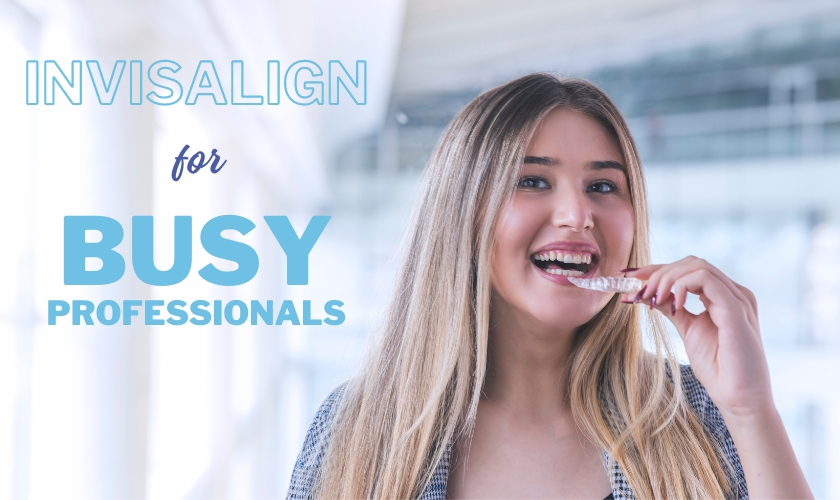
Invisalign has gained massive popularity as an alternative to traditional braces. It is a clear aligner system that helps straighten teeth while being nearly invisible. For many people, Invisalign offers a more discreet and comfortable option for improving their smile.
However, despite its many advantages, Invisalign is not the right choice for everyone. There are specific factors to consider before making a decision. This blog will explore those key factors to help you determine if Invisalign suits your dental needs.
By the end, you will have a clearer idea of whether it is the right fit for you and if consulting a dentist is your next step.
What is Invisalign?
Invisalign is a modern teeth-straightening system that uses clear, custom-made aligners. These aligners are created based on digital scans of your teeth. Over time, they gradually shift your teeth into the correct position.
The biggest appeal of Invisalign is its discreet appearance. Unlike traditional metal braces, these aligners are almost invisible, making them an excellent option for adults and teens who want a more subtle solution.
Additionally, Invisalign aligners are removable, allowing you to eat whatever you like without restrictions. This feature also makes brushing and flossing easier, helping maintain better oral hygiene throughout your treatment.
Comfort is another benefit, as the smooth plastic aligners reduce the chances of irritation compared to metal brackets. Overall, Invisalign has become a go-to option for those who want to straighten their teeth without compromising appearance or comfort.
Types of Dental Issues Invisalign Can Correct
Invisalign is an excellent choice for correcting various dental issues. It is designed to treat mild to moderate misalignment, making it effective for many people. Below are some common dental problems Invisalign can help fix:
- Mild to Moderate Crowding: Crowded teeth can cause discomfort and make oral hygiene difficult. Invisalign can gradually move crowded teeth into better alignment, allowing more space between them. This can improve both aesthetics and dental health.
- Gaps Between Teeth: Invisalign works well to close gaps between teeth. Whether the gaps are large or small, the aligners gradually shift teeth closer together, improving the overall look of your smile.
- Minor Bite Issues: Invisalign can also help with certain bite problems, such as overbite, underbite, and crossbite. For minor bite misalignments, the aligners apply gentle pressure to adjust your teeth and correct your bite.
However, it is important to note that more severe dental problems may not be suitable for Invisalign. Cases with significant overcrowding, complex bite issues, or severe misalignment might require traditional braces or other orthodontic treatments.
Consulting with an Invisalign dentist is crucial to determine the severity of your condition and if Invisalign can effectively address it.
Your Age and Invisalign
Invisalign is suitable for both teens and adults. The aligner system works well for those with all their adult teeth in place and who are looking for a more discreet way to straighten them.
There is a specific product for teens known as Invisalign Teen, which comes with additional features like compliance indicators. These indicators help ensure that teens wear their aligners for the required amount of time each day. The aligners also allow for the growth of incoming molars, a common concern during the teenage years.
Invisalign is also highly popular among adults. Many adults choose Invisalign because they want to improve their smile without the embarrassment of wearing traditional metal braces. Whether you’re in your 20s or 50s, Invisalign can offer a flexible, convenient solution to align your teeth without disrupting your daily life.
However, Invisalign is not recommended for younger children, as their teeth and jaws are still growing. Traditional orthodontics is often a better option for this age group.
Treatment Time and Commitment
On average, Invisalign treatment takes between 12 to 18 months. However, treatment time can vary depending on the complexity of your case. The more severe the misalignment, the longer it may take to achieve the desired results.
One key factor for success with Invisalign is wearing the aligners for 20-22 hours each day. The aligners should only be removed for eating, drinking (except water), brushing, and flossing. This makes patient commitment essential to the effectiveness of the treatment. If you do not wear the aligners as directed, your treatment may take longer, or you may not get the expected results.
Invisalign is a great option if you can commit to this schedule. Otherwise, traditional braces, which cannot be removed, maybe a better solution for you.
Lifestyle and Daily Habits
Invisalign offers flexibility that many people love. Since the aligners are removable, you can enjoy your favorite foods without worrying about damaging them. You won’t have to avoid sticky, hard, or chewy foods as you would with traditional braces.
However, this flexibility comes with responsibility. You must remember to put your aligners back in after eating or brushing. Failing to wear them consistently can delay treatment or affect results. Cleaning the aligners is also essential. You need to rinse and brush them regularly to avoid bacteria buildup.
Invisalign can fit well into an active lifestyle. If you play sports or travel frequently, the removable aligners make it easy to adjust as needed. Ensure you are disciplined enough to wear them for the recommended daily hours.
Comfort and Appearance
Invisalign aligners are known for their comfort and nearly invisible appearance. Unlike traditional braces that use metal brackets and wires, Invisalign aligners are made of smooth, clear plastic. This material reduces irritation to your gums and cheeks, making the aligners more comfortable to wear throughout the day.
One of the main reasons people choose Invisalign is its subtle, nearly invisible design. The aligners blend with your teeth, making them hard to notice unless someone looks closely. This feature appeals to those who are self-conscious about their appearance during treatment, especially in professional or social settings.
In addition, the aligners are custom-made to fit your teeth snugly, reducing discomfort compared to metal braces, which often cause pain after adjustments. Overall, Invisalign’s comfort and appearance make it a top choice for those looking for a more discreet and gentle way to improve their smile.
Consulting with an Orthodontist
Before starting Invisalign treatment, it is essential to consult with a licensed orthodontist or dentist who specializes in Invisalign. They will assess your teeth, bite, and specific dental concerns to determine if Invisalign is the right option for you.
The orthodontist will take digital scans or impressions of your teeth during the consultation. They will then develop a personalized treatment plan that outlines how Invisalign can address your dental issues. This is also the time to ask any questions you might have, including the estimated cost, treatment length, and expected outcomes.
An adept Invisalign provider can give you the confidence and guidance needed to ensure your treatment is successful. If Invisalign is not the best option for your dental needs, the orthodontist will recommend alternative treatments that can deliver the results you want.
Pros and Cons of Invisalign
Pros:
- Discreet appearance: Invisalign aligners are clear, making them barely noticeable compared to traditional braces.
- Comfort: The aligners are made from smooth plastic, reducing irritation in the mouth.
- Removability: You can take the aligners out when eating or brushing, allowing more flexibility in your daily routine.
- Easier cleaning and oral hygiene: Since the aligners are removable, you can brush and floss normally, which helps maintain good oral hygiene.
Cons:
- Requires discipline and responsibility: You must wear the aligners for 20-22 hours a day for the treatment to be effective.
- May not be suitable for severe dental problems: Complex cases might require traditional braces.
- Potential for lost or damaged aligners: Because they are removable, there is a risk of misplacing or damaging them.
Overall, the pros of Invisalign make it an attractive choice for those looking to straighten their teeth discreetly and comfortably.
Deciding whether Invisalign is right for you depends on several factors, including your type of dental issues, your age, and your commitment to the treatment process. Invisalign offers a discreet, flexible, and comfortable option for those with mild to moderate alignment issues.
Consulting with a dentist is the best way to assess whether this treatment suits your needs. They will guide you through the process and help you make an informed decision. Invisalign can truly be life-changing, giving you a straighter, healthier smile with minimal disruption to your daily routine.


